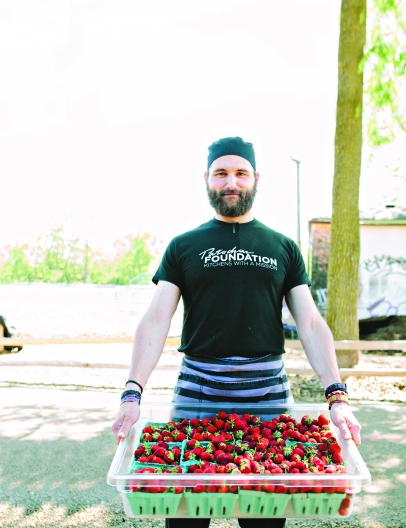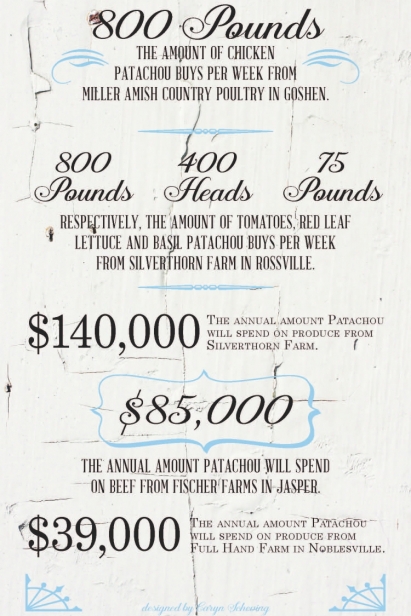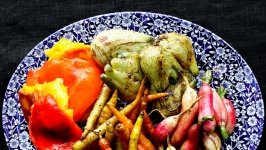Chef Tyler Herald: The real commitment in sourcing local foods
“Farm to table.”
“Locally sourced ingredients whenever possible.”
“Seasonal menu.”
These phrases appear regularly on restaurant menus, websites and marketing materials. They’ve become de rigueur when describing any new concept, and the use of these terms is rarely questioned.
Theoretically, every restaurant is “farm to table,” as the vegetables they use were most definitely grown on a farm somewhere and they eventually land on the table—but how many stops did those vegetables make along the way, and where was the farm that grew them? And what, exactly, does “whenever possible” mean? Five pounds of lettuce mix in July from a farm down the road? A bushel of peaches from the one time it was “possible” to get to a farmers’ market?
The fact is, many restaurants are talking the talk when it comes to “local” but not all of them are walking the walk. Granted, it’s not easy. Small local farmers are at the mercy of weather, transportation, yield and time, which can complicate the lives and schedules of chefs, who need to know what’s coming in and when as they’re planning their menus and juggling their inventories.
“You ordered 10 pounds of cucumbers, but the beetles got half of them. What do you want instead?”
“Not gonna have the radishes. Top of the roots got frozen.”
“The deer ate the lettuce.”
These are samples of the text messages that fly between Patachou’s Executive Chef Tyler Herald and local farmers on a regular basis, 24 hours a day, seven days a week, and he rolls with all of it.
Tyler Herald is walking the walk.
With the walk-ins of 10 busy restaurants to stock, it would be easy to decide that dealing with more than 20 different small purveyors is too complicated, when he could just pick up the phone and get everything he needs from one source. But Herald has a commitment to all things local that runs deep.
“For me, it started when I was kid, hanging out in my mom’s restaurant,” said Herald. “We would pick up some tomatoes from a roadside market, or a customer would bring in a bag of cucumbers from the surplus of their garden, and I remember thinking, ‘Wow, this tastes so much better than the other stuff.”
As his travels took him to Wisconsin and Oregon in the late ’90s and in early 2000, he noticed the trend of restaurants putting the names of the local farms they bought from right on the menus. And when he finally landed at Café Patachou in 2008, he found a kindred spirit in his commitment to local in Martha Hoover.
What is Local?
For Herald, “local” is defined as anything from the state of Indiana, from as far away as 130 miles and as close as the garden just outside the front door of Public Greens (one of the many restaurants that are part of the Patachou family). He takes enormous pride in the fact that in the summer months, the menus at Napolese (also a Patachou cousin) and Public Greens are nearly 100% local, with the exception of Parmesan cheese, which no one in Indiana produces.
This commitment is the reason you might find Great Lakes trout on a menu, but never shrimp. And why you’ll never be able to get a Caprese salad in February.
“When we opened Napolese, our customers learned quickly that it wasn’t going to do them any good to complain about their favorite salad going off the menu. They realized that it would return the next year. And in the winter months, they grew to embrace Brussels sprouts,” he said with an impish grin.
As we chat on a rainy and chilly March morning, he gets a faraway look in his eyes as he dreams about the summer bounty that’s just around the corner.
“There is a night-and-day difference between local arugula, spinach and tomatoes” and their counterparts trucked in from across the country or beyond, said Herald. “Literally, night and day. And the strawberries… oh, the strawberries... I remember a few years ago I tasted a strawberry from Wild’s Apple Farm in Zionsville, and I ran to the other cook in the kitchen and I was like, ‘Taste this, man! This, this is what a strawberry is supposed to taste like!’ They shouldn’t even be allowed to call those other things strawberries. It’s a completely different fruit.”
The Relationships
For Herald, the relationships he develops with the local farmers are just as important as the quality of the food they provide. Some of these farmers have adapted their business models to grow exclusively, or nearly exclusively, for Patachou.
“I’ve known some of these farmers for years,” he said. “I know their families. I’ve watched their children grow up. These folks don’t do it to get rich. They don’t do it to buy fancy cars. They do it out of love and passion and I believe we have an obligation to support that.”
Another source for local produce is Butler University’s Center for Urban Education (CUE). “The students actually approached me,” said Herald. “And of course I said yes.” In the summer months, the student growers bring a bounty of tomatoes, peppers, green beans, kale, arugula, snap peas, squash and asparagus.
Logistics
For the most local of the local growers, transportation is no problem. But for some that travel from the farther corners of Indiana, logistics can be tricky.
“With Gunthorp, it’s one guy, one truck,” said Herald. “Greg [Gunthorp] is just loading it all up once a week and driving it over here. If his truck breaks down, we’re all in trouble.”
Deliveries from so many different vendors makes for hectic kitchen back doors.
“There are people in and out of the delivery door all day long sometimes,” Herald said. “And growers that I haven’t even ordered from will stop by and ask if I’m interested in what they have left over from a farmers’ market. Or maybe they had a bumper crop of something. I always take it off their hands if I can.”
Dollars and Sense
Herald does concede the price he’s willing to pay for locally produced ingredients might be more than some smaller restaurants can get past. After all, he’s got the buying power of 10 restaurants behind him, and an owner who firmly believes quality trumps price every time. But no matter how much the principle of economies of scale applies, each plate that leaves the kitchen has to make money or everyone involved is out of work. Yet tending to a food cost percentage can be especially tricky when a couple of weeks without rain can double the price of a particular ingredient. Herald has learned to work around this over the years by pricing on the average of ingredient costs.
Is It Worth It?
Herald conceded that it takes “a ton” more effort to do what he’s doing with local farmers.
“But everything we do ties into the mission. Public Greens is all about feeding the local community. How would it look if we were using food from out of the state or out of the country to do that?”
There was a time when Herald did all of the ordering for all of the restaurants himself, but he’s learned he has to delegate. But he is ever vigilant that all of the kitchen staff in all the restaurants shares his passion and his respect for the work of the farmers who grow for them.
“It takes a lot to make me mad,” he said. “But if I walk into a kitchen and someone has tossed something on top of a clamshell of beautiful strawberries, I will go nuts on them. You know, you have to respect the circle of life. If you waste one clamshell of strawberries, you didn’t just waste the strawberries. You wasted all of the time, effort and love of the farmer who worked so hard to grow those strawberries. You’d better respect it. Cherish it.”
Expanding the Reach
As Indianapolis diners hungrily gobble up every bite of “local” Herald and his culinary team can put on their plates, Hoover and Herald are eyeing broader plains. Communities such as Bloomington and Nashville may soon enjoy what Circle City residents have come to take for granted.
“We’re definitely talking about more restaurants in new cities,” said Herald. “And how exciting is that? A whole new ‘local’ to explore; a new ecosystem. Things grow there that don’t grow here. They call the Midwest ‘the Heartland’ for a reason. It would suck to live someplace like Texas, where the seasons don’t change. How boring would that be? Indiana has an amazing bounty to offer. There’s nowhere else I’d rather be cooking.”









